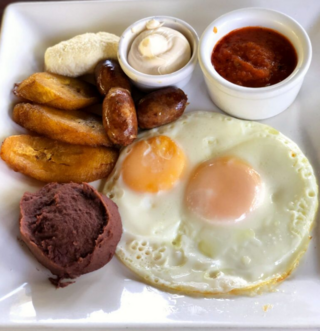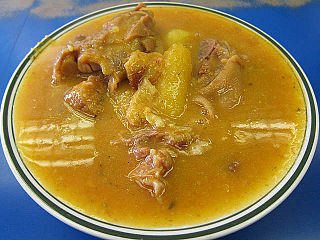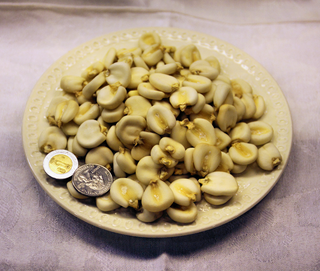
Tripe is a type of edible lining from the stomachs of various farm animals. Most tripe is from cattle, pigs and sheep.

Costa Rican cuisine is known for being mostly mild, with high reliance on fruits and vegetables. Rice and black beans are a staple of most traditional Costa Rican meals, often served three times a day. Costa Rican fare is nutritionally well rounded, and nearly always cooked from scratch from fresh ingredients. Owing to the location of the country, tropical fruits and vegetables are readily available and included in the local cuisine.

Latin American cuisine is the typical foods, beverages, and cooking styles common to many of the countries and cultures in Latin America. Latin America is a highly racially, ethnically, and geographically diverse with varying cuisines. Some items typical of Latin American cuisine include maize-based dishes arepas, empanadas, pupusas, tacos, tamales, tortillas and various salsas and other condiments. Sofrito, a culinary term that originally referred to a specific combination of sautéed or braised aromatics, exists in Latin American cuisine. It refers to a sauce of tomatoes, roasted bell peppers, garlic, onions and herbs. Rice, corn, pasta, bread, plantain, potato, yucca, and beans are also staples in Latin American cuisine.

Salvadoran cuisine is a style of cooking derived from the nation of El Salvador. The indigenous foods consist of a mix of Amerindian cuisine from groups such as the Lenca, Pipil, Maya Poqomam, Maya Chʼortiʼ, Alaguilac and Cacaopera peoples. Many of the dishes are made with maize (corn). There is also heavy use of pork and seafood. European ingredients were incorporated after the Spanish conquest.

Sopa de mondongo is a soup made from diced tripe slow-cooked with vegetables such as bell peppers, onions, carrots, cabbage, celery, tomatoes, cilantro, garlic or root vegetables. The dish is generally prepared in former Spanish colonies in Latin America, Caribbean, and in the Philippines.

Colombian cuisine is a culinary tradition of the six main regions within Colombia. Colombian cuisine varies regionally and is influenced by Indigenous Colombian, Spanish, and African cuisines, with a slight Arab influence in some regions.

Ghanaian cuisine refers to the meals of the Ghanaian people. The main dishes of Ghana are centered around starchy staple foods, accompanied by either a sauce or soup as well as a source of protein. The primary ingredients for the vast majority of soups and stews are tomatoes, hot peppers, and onions. As a result of these main ingredients, most Ghanaian soups and stews appear red or orange.

Cuchifritos or cochifritos refers to various fried foods prepared principally of pork in Spanish and Puerto Rican cuisine. In Spain, cuchifritos are a typical dish from Segovia in Castile. The dish consists of pork meat fried in olive oil and garlic and served hot. In Puerto Rico they include a variety of dishes including morcilla, papas rellenas, and chicharron, and other parts of the pig prepared in different ways. Some cuchifritos dishes are prepared using plantain as a primary ingredient. Cuchifritos vendors also typically serve juices and drinks such as passionfruit, pineapple, and coconut juice, as well as ajonjolí, a drink made from sesame seeds.

Dominican cuisine is made up of Spanish, indigenous Taíno, Middle Eastern, and African influences. The most recent influences in Dominican cuisine are from the British West Indies and China.

Most traditional foods in Guatemalan cuisine are based on Maya cuisine, with Spanish influence, and prominently feature corn, chilies and beans as key ingredients. Guatemala is famously home to the Hass avocado.

Ecuadorian cuisine is diverse, varying with altitude and associated agricultural conditions. Ecuadorian cuisine is an amalgamation of Spanish, Andean, and Amazonian cuisines and to a lesser degree Italian, Lebanese, African, and Chinese. Beef, chicken, and seafood are popular in the coastal regions, especially ceviche, and are typically served with carbohydrate-rich foods, such as rice accompanied with lentils, pasta, or plantain. In the mountainous regions pork, chicken, beef and cuy are popular and are often served with rice, maize, or potatoes. A popular street food in mountainous regions is hornado, consisting of potatoes served with roasted pig. Some examples of Ecuadorian cuisine in general include patacones, llapingachos, and seco de chivo. A wide variety of fresh fruit is available, particularly at lower altitudes, including granadilla, passionfruit, naranjilla, several types of banana, uvilla, taxo, and tree tomato.

Puchero is a type of stew originally from Spain, prepared in Yucatán, Mexico, Argentina, Paraguay, Uruguay, Perú, south of Brazil, the Philippines, and Spain, specifically the autonomous communities of Andalusia and the Canary Islands. The Spanish word "puchero" originally meant an earthenware pot, before being extended to mean any vessel, and then the dish cooked in it.

Mote is the generic name for several varieties of boiled grains, consumed in many regions of South America. It is usually prepared by boiling the grains in water made alkaline by the addition of ashes or lime, a process known as nixtamalization.
The seco is a stew typical of Ecuadorian and Peruvian cuisine. It can be made with any type of meat. According to an Ecuadorian popular etymology, the name of seco comes from the Península de Santa Elena in Ecuador, where at the beginning of the 20th century a camp English did oil work in Ancón, when referring to the second course of food, in English "second", the Ecuadorians repeated deforming the word until they reached the current "seco", which has been widely disseminated, despite being a myth, since records of this dish have been found since 1820, almost a century before the English presence in the Santa Elena Peninsula. At that time, deer and Creole goats abounded. According to the Dictionary of Peruvianisms of the Peruvian Wings University, seco is a «stew of beef, kid or another animal, macerated in vinegar, which is served accompanied by rice and a sauce of ají, huacatay and cilantro". Thus, its main characteristic is to marinate and cook the chosen meat with some type of sauce acid, such as chicha, beer, naranjilla or vinegar.

Tostones are twice-fried plantain slices commonly found in Latin American cuisine and Caribbean cuisine. Most commonly known as tostones in Jamaica, Puerto Rico, Mexico, Nicaragua, Cuba, Dominican Republic, Honduras and Venezuela, they are also known as tachinos or chatinos (Cuba), bannann peze (Haiti), patacones and, sometimes, patacón pisao in Colombia.

Chifles, fried plantain chips, are a side dish, snack food, or finger food of Ecuador, Thailand and Peru.






















